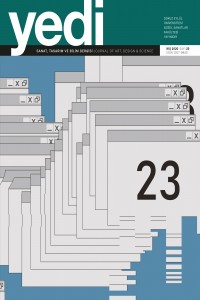Research Article
Year 2020,
Issue: 23, 11 - 20, 23.01.2020
Abstract
Bu çalışmada, tasarım eğitiminde
sembolik öneme sahip ve öğrenmenin vaz geçilmez bir parçası olarak görülen
tasarım jürilerinde, öğrencilerin kullanması için ‘retorik model’
önerilmektedir. Bu özgün modelde öğrencilerin tasarım fikirlerini anlatmaları
ve projelerini jüri üyeleri önünde savunmaları için sistemli aşamalar ve
öneriler bulunmaktadır. Aşamalar jüri süreci ve akışı dikkate alınarak
planlanmış ve öneriler de Aristoteles’in retorik teorisi üzerine
yapılandırılmıştır. Hem sözle hem de görsel iletişim öğelerinin planlanmasına
ilişkin model, öğrencilere rehber olacak ve etkili sunum yapmalarında fayda
sağlayacaktır.
Keywords
References
- Aristoteles. (2016). Retorik (Çev. Mehme). İstanbul: Y.K.Y.
- Buchanan, R. (1985). Declaration by Design: Rhetoric, Argument, and Demonstration in Design Practice. Design Issues, 2(1), 4. https://doi.org/10.2307/1511524.
- Cross, N. (1999). Design Research: A Disciplined Conversation. Design Issues, 15(2), 5–10.
- Frederickson, M. P. (1990). Design Juries: A Study in Lines of Communication. Journal of Architectural Education, 43(2), 22–27. https://doi.org/10.1080/10464883.1990.10758556
- Gurel, M. O., & Basa, I. (2004). The status of graphical presentation in interior/architectural design education. International Journal of Art and Design Education, 23(2), 192–206. https://doi.org/10.1111/j.1476-8070.2004.00397.x
- Heath, R. L. (2004). Halkla ilişkiler için retoriksel bir uygulama. Içinde H. Güz & S. Y. Becerikli (Ed.), Halkla İlişkilerde Seçme Yazılar (ss. 107–154). Ankara: Alban Tanıtım.
- Ilgaz, A. (2009). Design Juries As a Means of Assessment and Criticism in Industrial Design Education: A Study on Metu Department of Industrial Design. METU.
- Kaufer, D. S., & Butler, B. S. (2013). Rhetoric And The Art Of Design. New York: Routledge.
- L’Etang, J. (2002). Halkla İlişkiler ve Retorik. Içinde J. L’Etang & M. Pieczka (Ed.), Halkla İlişkilerde Eleştirel Yaklaşımlar (1.baskı, ss. 189–213). Ankara: Vadi Yayınları.
- McCormack, K. C. (2014). Ethos, Pathos, and Logos: The Benefits of Aristotelian Rhetoric in the Courtroom. Washington University Jurisprudence Review, 131(1), 131–155. Tarihinde adresinden erişildi http://openscholarship.wustl.edu/law_jurisprudence/vol7/iss1/9
- Muratovski, G. (2016). Research for designers: A guide to methods and practice. SAGE Publications.
- Schön, D. (1985). The design studio: An exploration of its traditions and potentials. International Specialized Book Service Incorporated.
- Schön, D. (1988). Toward a Marriage of Artistry & Applied Science In the Architectural Design Studio. Journal of Architectural Education, 41(4), 4–10. https://doi.org/10.1080/10464883.1988.10758496
- Webster, H. (2006). A Foucauldian look at the Design Jury. Art, Design & Communication in Higher Education, 5(1), 5–19. https://doi.org/10.1386/adch.5.1.5_1
- Webster, H. (2007). The analytics of power: Re presenting the design jury. Journal of Architectural Education, 21.
Year 2020,
Issue: 23, 11 - 20, 23.01.2020
Abstract
References
- Aristoteles. (2016). Retorik (Çev. Mehme). İstanbul: Y.K.Y.
- Buchanan, R. (1985). Declaration by Design: Rhetoric, Argument, and Demonstration in Design Practice. Design Issues, 2(1), 4. https://doi.org/10.2307/1511524.
- Cross, N. (1999). Design Research: A Disciplined Conversation. Design Issues, 15(2), 5–10.
- Frederickson, M. P. (1990). Design Juries: A Study in Lines of Communication. Journal of Architectural Education, 43(2), 22–27. https://doi.org/10.1080/10464883.1990.10758556
- Gurel, M. O., & Basa, I. (2004). The status of graphical presentation in interior/architectural design education. International Journal of Art and Design Education, 23(2), 192–206. https://doi.org/10.1111/j.1476-8070.2004.00397.x
- Heath, R. L. (2004). Halkla ilişkiler için retoriksel bir uygulama. Içinde H. Güz & S. Y. Becerikli (Ed.), Halkla İlişkilerde Seçme Yazılar (ss. 107–154). Ankara: Alban Tanıtım.
- Ilgaz, A. (2009). Design Juries As a Means of Assessment and Criticism in Industrial Design Education: A Study on Metu Department of Industrial Design. METU.
- Kaufer, D. S., & Butler, B. S. (2013). Rhetoric And The Art Of Design. New York: Routledge.
- L’Etang, J. (2002). Halkla İlişkiler ve Retorik. Içinde J. L’Etang & M. Pieczka (Ed.), Halkla İlişkilerde Eleştirel Yaklaşımlar (1.baskı, ss. 189–213). Ankara: Vadi Yayınları.
- McCormack, K. C. (2014). Ethos, Pathos, and Logos: The Benefits of Aristotelian Rhetoric in the Courtroom. Washington University Jurisprudence Review, 131(1), 131–155. Tarihinde adresinden erişildi http://openscholarship.wustl.edu/law_jurisprudence/vol7/iss1/9
- Muratovski, G. (2016). Research for designers: A guide to methods and practice. SAGE Publications.
- Schön, D. (1985). The design studio: An exploration of its traditions and potentials. International Specialized Book Service Incorporated.
- Schön, D. (1988). Toward a Marriage of Artistry & Applied Science In the Architectural Design Studio. Journal of Architectural Education, 41(4), 4–10. https://doi.org/10.1080/10464883.1988.10758496
- Webster, H. (2006). A Foucauldian look at the Design Jury. Art, Design & Communication in Higher Education, 5(1), 5–19. https://doi.org/10.1386/adch.5.1.5_1
- Webster, H. (2007). The analytics of power: Re presenting the design jury. Journal of Architectural Education, 21.
There are 15 citations in total.
Details
| Primary Language | Turkish |
|---|---|
| Journal Section | Araştırma Makaleler |
| Authors | |
| Publication Date | January 23, 2020 |
| Submission Date | July 29, 2019 |
| Acceptance Date | December 11, 2019 |
| Published in Issue | Year 2020 Issue: 23 |
Cited By
REKLAMDA RETORİK ANLATIM
Uluslararası Halkla İlişkiler ve Reklam Çalışmaları Dergisi
https://doi.org/10.61766/hire.1489628
This work is licensed under a Creative Commons Attribution 4.0 International License.


